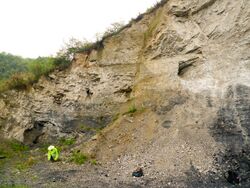Earth:Dengying Formation
From HandWiki
| Dengying Formation Stratigraphic range: Ediacaran ~551–541 Ma | |
|---|---|
 Transition between uppermost Doushantuo Formation and lowermost Dengying Formation | |
| Type | Formation |
| Sub-units | See: Members |
| Underlies | Yanjiahe Formation[1] |
| Overlies | Doushantuo Formation |
| Location | |
| Region | Yangtze Gorges |
| Country | |
The Dengying Formation is an upper Ediacaran (551-541 Ma[2]) fossiliferous geologic formation found in South China. It was deposited on a shallow marine carbonate platform.[3]
Members
Listed by ascending age:
- The Hamajing Member is characterized by light grey, medium- to thick-bedded dolomite, intercalated with thin layers of chert.[3]
- The Shibantan Member is interpreted to represent a subtidal environment and is composed of dark grey, thin-bedded bituminous limestone. It is the most fossiliferous of the Dengying Formation members and has yielded several trace fossils, such as Lamonte.[4]
- The Baimatuo Member consists of light grey, thick-bedded dolomite.[3]
Traditionally, the Tianzhushan Member was considered to be the uppermost unit of the Dengying Formation. However, its small shelly fossils and Micrhystridium-like acritarchs are a shared characteristic with the Cambrian Yanjiahe Formation.[3]
Genera
- Cloudina
- Paracharnia
- Sinotubulites
- Yangtziramulus
Ichnogenera
- Helminthoidichnites
- Lamonte
- Torrowangea
See also
- List of fossiliferous stratigraphic units in China
- Ediacaran biota
References
- ↑ Dong, Lin; Xiao, Shuhai; Shen, Bing; Zhou, Chuanming; Guoxiang, Li; Yao, Jinxian (2009). "Basal Cambrian Microfossils from the Yangtze Gorges Area (South China) and the Aksu Area (Tarim Block, Northwestern China)". Journal of Paleontology 83 (1): 30–34. doi:10.1666/07-147R.1. http://jpaleontol.geoscienceworld.org/content/83/1/30.abstract. Retrieved 15 August 2014.
- ↑ Condon, Daniel; Zhu, Maoyan; Bowring, Samuel; Wang, Wei; Yang, Aihua; Jin, Yugan (2005). "U–Pb ages from the Neoproterozoic Doushantuo Formation, China". Science 308 (5718): 5–98. doi:10.1126/science.1107765. PMID 15731406.
- ↑ 3.0 3.1 3.2 3.3 Zhou, Chuanming; Xiao, Shuhai (2006). "Ediacaran .δ13C chemostratigraphy of South China". Chemical Geology 237 (1–2): 89–108. doi:10.1016/j.chemgeo.2006.06.021.
- ↑ Meyer, Mike; Xiao, Shuhai; Gill, Benjamin C.; Schiffbauer, James D.; Chen, Zhe; Zhou, Chuanming; Yuan, Xunlai (2014). "Interactions between Ediacaran animals and microbial mats: Insights from Lamonte trevallis, a new trace fossil from the Dengying Formation of South China". Palaeogeography, Palaeoclimatology, Palaeoecology 396: 62–74. doi:10.1016/j.palaeo.2013.12.026.
 |

